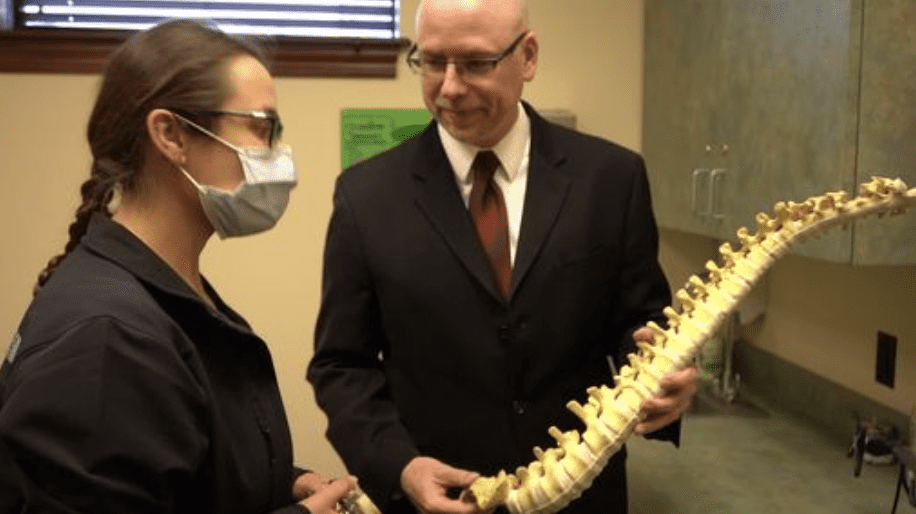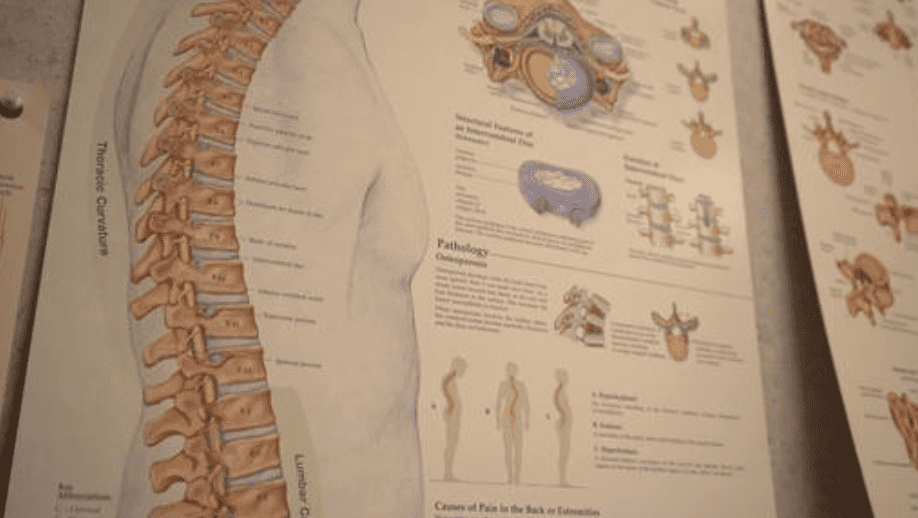- What happens during a spinal compression fracture?
- What causes a spinal compression fracture?
- What are the treatments for a spinal compression fracture?
- What’s the difference between a kyphoplasty and a vertebroplasty?
- What’s it like to recover from the kyphoplasty or vertebroplasty procedure?
Osteoporosis is a common condition that often leads to vertebral spinal compression fractures caused by bone density loss. A spinal compression fracture is painful; the vertebrae collapses, causing bone to press on the spinal cord and nerves.
If you’ve been diagnosed with a fracture of this type, there is some good news. There are two surgical procedures for the spine, called kyphoplasty and vertebroplasty that can help give you your life back. This blog will help you understand what to expect.
What Happens During a Spinal Compression Fracture?
 A spinal compression fracture occurs when the vertebrae in your spine break. The vertebrae themselves serve an important function in your mobility. These small bones are stacked together to make up the spinal column. Your spine allows you to move and protects the nerves that go from the brain to the rest of your body.
A spinal compression fracture occurs when the vertebrae in your spine break. The vertebrae themselves serve an important function in your mobility. These small bones are stacked together to make up the spinal column. Your spine allows you to move and protects the nerves that go from the brain to the rest of your body.
When a compression fracture happens, the vertebrae collapses, making the entire structure shift. It can put pressure on the nerves in the spinal column and even pinch off the blood and oxygen that flow in these areas.
What Causes a Spinal Compression Fracture?
Osteoporosis is a common cause of a compression fraction of the spine. It is a disease that weakens bones and makes them brittle and easier to break.
Other possible causes of a spinal compression fracture include a spinal tumor or a spinal injury such as in a car wreck or from sports. However, most spinal compression fractures happen simply as a part of the body’s natural aging process.
Both men and women can suffer from these fractures, which cause symptoms such as:
- Back pain that slowly gets worse over time
- Decreased height as you age
- Inability to move or twist (limited spinal movement)
- Posture that is hunched or stooped
- Weak muscles, tingling extremities, numbness and problems controlling your bowels or bladder
If the compression fracture occurs suddenly, then you may feel intense back pain that quickly becomes debilitating.
What Are the Treatments for a Spinal Compression Fracture?
 If your spinal compression fracture is caused by osteoporosis, the doctor will likely treat that condition first. You may receive: vitamins and medication to strengthen the bones. Your doctor may also recommend physical therapy to strengthen the bones and underlying tissues. Some other treatments may include:
If your spinal compression fracture is caused by osteoporosis, the doctor will likely treat that condition first. You may receive: vitamins and medication to strengthen the bones. Your doctor may also recommend physical therapy to strengthen the bones and underlying tissues. Some other treatments may include:
- A back brace to support the spine
- Bed rest for a time
- Limited activity to allow your bones to heal
- Pain medication for your back pain
These are all conservative treatments that your doctor may try before surgery. There are two surgical procedures to correct the spinal compression fracture: Kyphoplasty and vertebroplasty.
What’s the Difference Between a Kyphoplasty and a Vertebroplasty?
The kyphoplasty procedure is quite similar to vertebroplasty. Both procedures solve the same problem of spinal compression fracture. In both procedures, 80 to 90% of patients experience pain relief. The difference between kyphoplasty and vertebroplasty lies in the processes used during these procedures.
In kyphoplasty surgery, small balloons are inserted and filled between the spinal vertebrae. This lengthens the spine and makes the vertebrae taller. Then the balloons are removed and the space is filled with a quick drying medical cement to support the spinal column. This eliminates the pressure and relieves pain.
The vertebroplasty procedure to correct a spinal compression fracture is very similar to kyphoplasty but doesn’t use balloons. During the vertebroplasty surgical procedure the doctor injects a small amount of quick setting medical cement directly into the fractured vertebrae. The cement shores up the broken bone and can provide some pain relief.
What’s It Like to Recover From Kyphoplasty or Vertebroplasty?
 Both kyphoplasty and vertebroplasty can be done in an outpatient setting for patients with no complicating factors. Since both procedures are very similar, the recovery for both is also about the same. In both procedures, you can expect the following to occur.
Both kyphoplasty and vertebroplasty can be done in an outpatient setting for patients with no complicating factors. Since both procedures are very similar, the recovery for both is also about the same. In both procedures, you can expect the following to occur.
- You will be under a local anesthesia while lying face down on an operating table
- Your surgeon will use X-rays to carefully guide the balloon catheter (kyphoplasty) or just the needle (vertebroplasty) into the broken vertebra
- Your surgeon will then fill the vertebra with medical cement, which hardens in about 10 minutes
After the surgery and a couple of hours of being monitored, you’ll be able to go home to continue recuperating, but you will need someone to drive you. At home you may experience some back soreness for one to two days in the area where the procedure was completed. We usually recommend an ice pack and an over-the-counter pain reliever.
You may be surprised by how quickly your back pain subsides, though every patient is different. Typically, we see patients resume their lives fully after two or three weeks of at-home recovery. However, you won’t want to do heavy lifting or intense exercise for a few weeks after the procedure. During this time, you’ll see your surgeon regularly to check on your progress, and physical therapy may also be recommended to ease your recovery.
Orlando Neurosurgery can help patients suffering from spinal and back pain. There is no reason to suffer when expert care is just a phone call away. Contact us today to schedule an appointment.
Sign Up for Our Newsletter
Get the latest news and updates from Orlando Neurosurgery delivered straight to your inbox.


